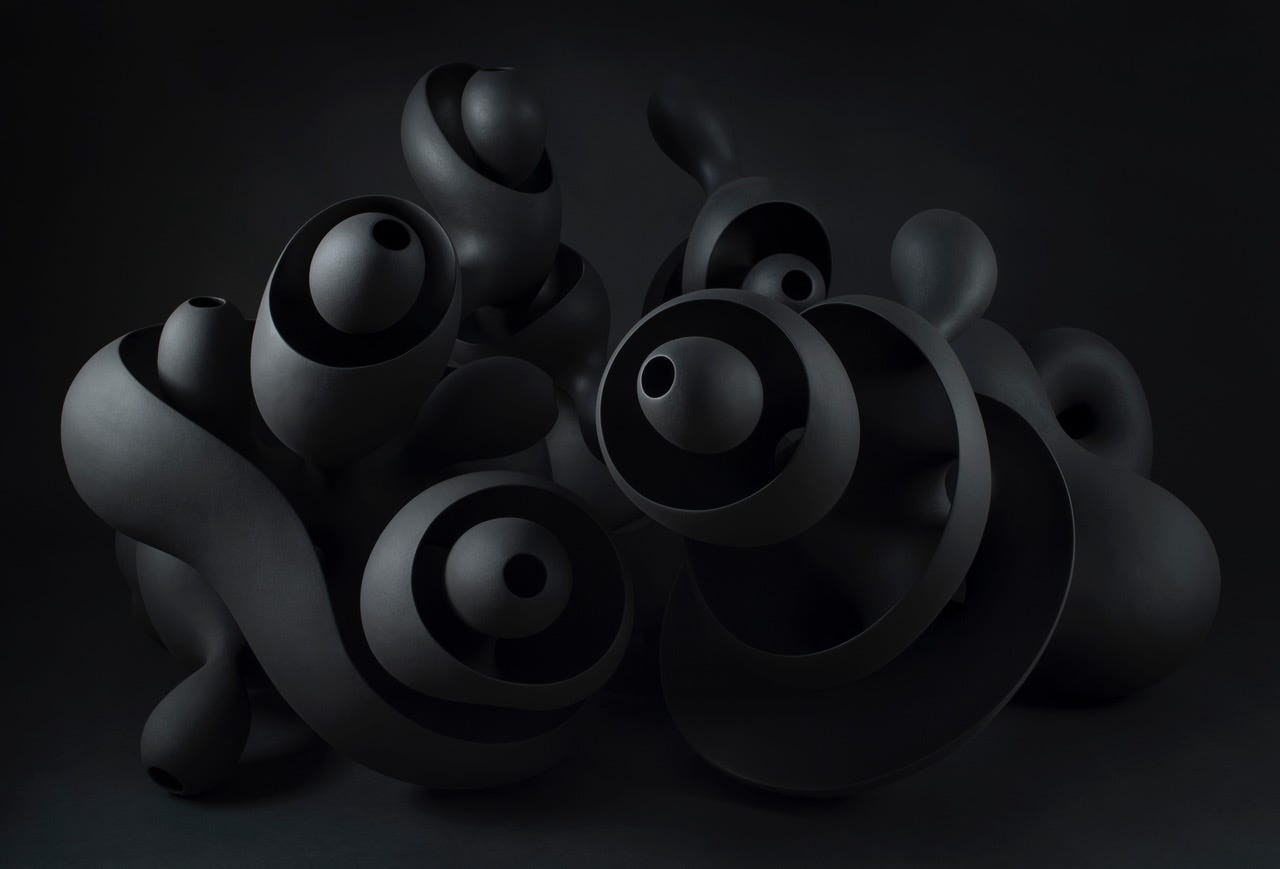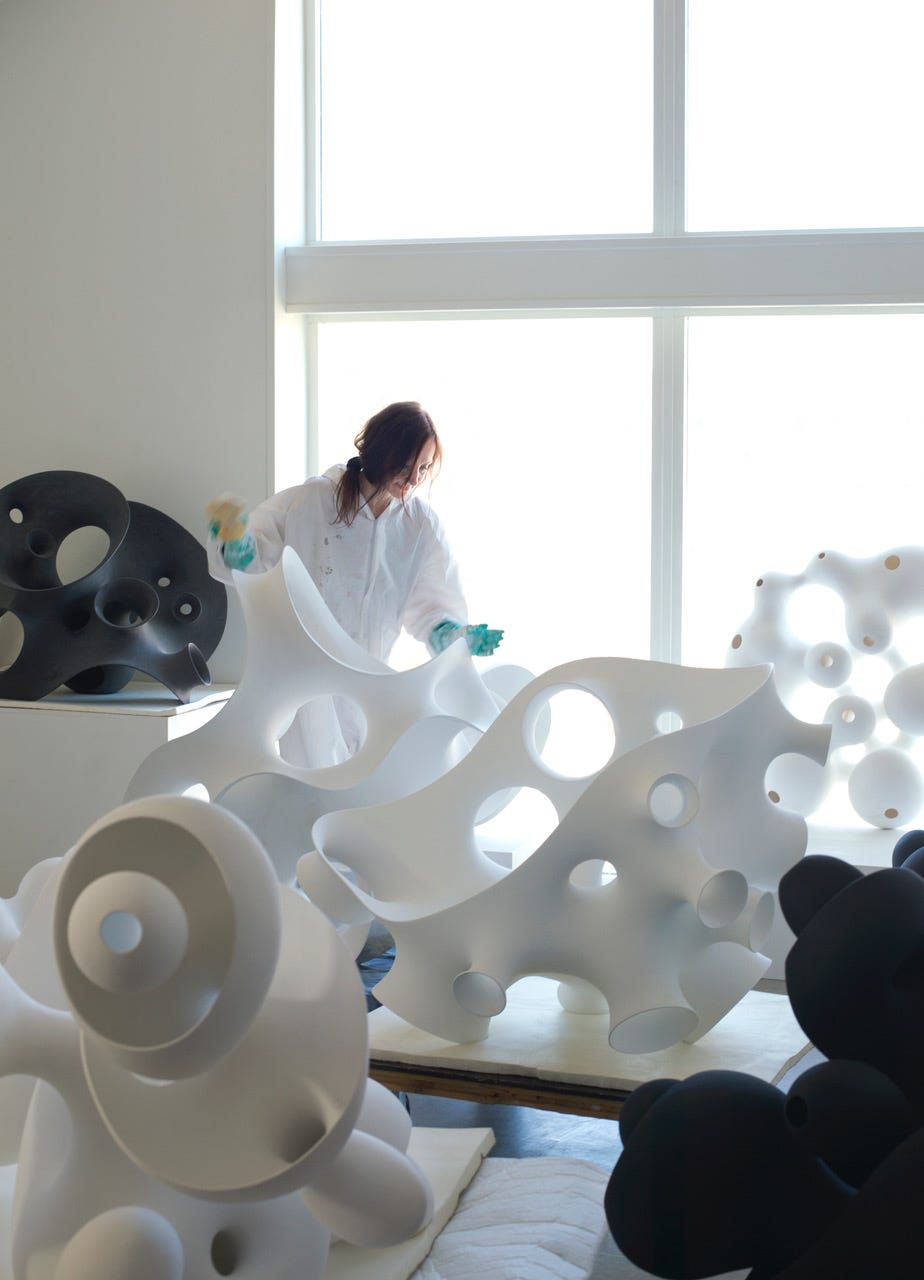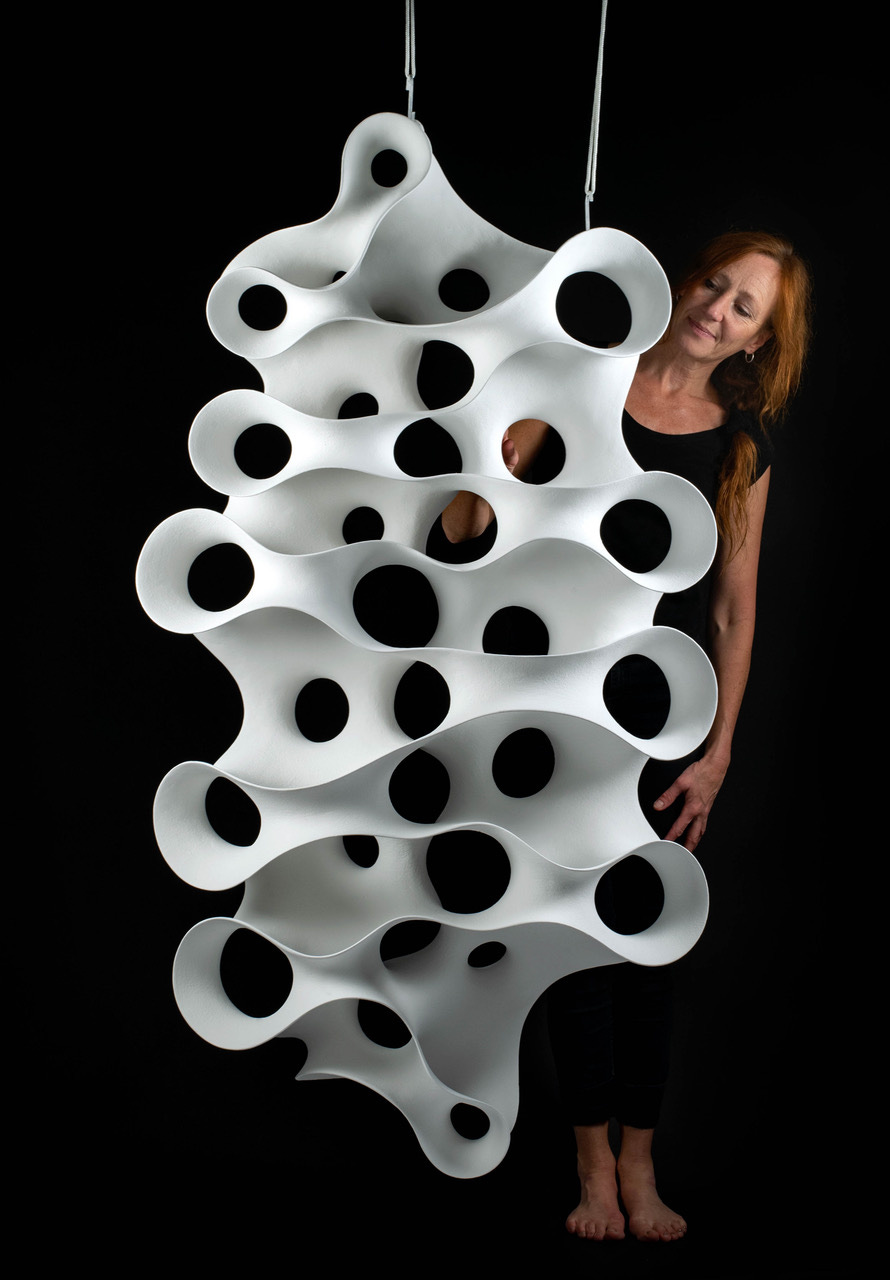The Inner Landscape of Eva Hild
Chatting With Tarantula: Authors and Art's Artist of October, Eva Hild
Following the “röd tråd” (red thread) connecting her art works, we enter a unique inner landscape that holds the clue to what does it mean to be the artist Eva Hild. Bouncing from the smaller sculptures to the ones of monumental sizes decorating playgrounds and parks, we as the viewers turn into Alice in Wonderland, instantly growing or becoming smaller, looking bubbly or distorted as we stand further or approach the sculptures closer. After a bit of reflection, we realize that the highs and the lows, the bumps and the smooth slides hidden in the interior world of this Swedish artist, are actually just mere reflections of our own state of mind.
Eva Hild doesn’t shy away from her interior world. She publicly confesses that her sculptures are her own emotional portraits. And why shouldn’t she? Her inner landscape is the source where her imagination and creativity, intuition and a multitude of feelings depending on which life season she started working on a sculpture, meet, grow, fall apart and turn into beautiful bodies. Her sculptures are smooth and wavy, rough and rupturing as if showing that their birth wasn’t easy to come by. The ones with more emptiness tell us the story of her post-small-children-and-divorce life, while the dense and more filled sculptures tell us a story of her family life. All of their curves and angles, uphills and descends weave into a beautiful dance of life.
When visiting her works in a gallery, life and art mirror each other, artist and the audience melt into one. Eva Hild’s body of works crack our own bodies open to show both, the ugly and beautiful, the skeletons, the crevices, the chi that fills and swirls throughout the holes teaching us to just accept who we are and be.
Tarantula Authors And Art: Do you remember what led you to become an artist and sculptor? Was sculpture your first love/form of expression?
Eva Hild: The curiosity and interest of artistic expressions have always been there. From my early years, I have been fascinated by body, shape, colour, material, handicraft, nature - but it took some time to realize that art could be my main occupation, a profession.
My grandfather had a traditional paint shop and supported me with a wide range of materials and left-overs. My grandmother was a textile craft person, always occupied with needlework, tie-dye and sewing. In the sensitive younger years, I was a bit lost and confused - thought I should study medicine (as my parents) but hesitated and turned to physiotherapy (as a compromise). When I finally discovered art and ceramics in a serious way, I started feeling unhappy and less connected with my former education.
”Before she kneaded muscles, now she kneads clay.”
Today, I am convinced that all my acquired knowledge nourishes and comes together in my artistic work. Even though the entry point into my art is psychological, the sculptures contain a lot of references to the body - like balance, movement, weight, positions. A roundabout way could be enriching, seen in the back mirror.
I have always been attracted to sculpture and shape. I relate them to my own body and sense the different shapes and materials. I love how three-dimensional work could change when moving around, coming closer. I love materials. How they make an impact, how the same shape could differ in various performances, how a material could communicate a story, a sensibility. I love craft work - and have always something on-going in my hands.
My way into the art world was mainly through ceramics. In the beginning, I tried every technique and fulfilled every idea that came into my head. The challenge and long process during my education, was to find my own track - my ”red thread”. I found my themes and way of working - and it has become more of a weave (but with the same ingredients).
I heard you talk about your process at the GSA gallery. You mentioned that you start with just a small coil. Can you tell our readers about all the small steps you take to create a large sculpture from the coil?
My starting point, at first, is empty space - a hole. I start with a small lump of clay, making a coil in a circle. My technique is traditional - with adding small coils, the shape slowly grows. The key to my work is time (a single sculpture could take 6 months to one year to fulfill,) patience (not be in a hurry, let it grow slowly,) intuition (listen to the material - a relation that develops during time,) control (to know when it is time to add the next coil, to turn the shape, to use more or less water) and courage (follow your ideas, challenge the material and find solutions).
The clay is an amazing material - dries slowly, is flexible, could be made in almost any shape, a natural and direct material, easy to find, not so expensive, stable when handled in a careful and artful way. I love the directness and plasticity in the fresh clay, and later in the process the transformation in the kiln - to a sustainable and eternal material.
All your sculptures are intricate. How do you choose the size and material for any given piece? Does size matter?
Yes, size matters… and gives different experiences. Intimate or monumental.
My main idea is that the sculptures should be relatable in size to my own body - they are reflecting my inner landscape. Mostly, I am drawn to work in the slightly bigger scale. My sculptural work is almost always starting in the clay - and the size is limited in the ceramic material. When translating my ceramic models to metal materials, I try to visualize the scale and expression in a specific shape. There are many factors affecting a specific decision: the idea of a shape, a possible placement, architectural qualities, a possible budget (more holes, less material …) limited doorways or container-sizes … I like to be drawn into the sculptures - to see them as equal organisms. Still, I have periods when I try new ideas in a slightly smaller, more intimate scale. And the other way around - when I am working with sculptures for a public space - sometimes the bigger the better - the artwork should be inviting and interact in a surrounding.
You call your sculptures emotional self portraits, I was wondering if you can pick one of your sculptures and tell us its story?
All my sculptures have different stories, not always articulated, but could be described as emotions, positions, relations, experiences or movements. The thin-walled sculptures could be seen as containers - a vessel shape - a body - a membrane exposed to inner and outer movements. I relate to how my own inner room could be affected - dissolved - turned inside out. How emotions cold create flow, lightness and fusions. How powerful and aggressive feelings could be translated into closed, bulging shapes.
Here some examples:
To be in a state of constant change, a flow, fluctuation, motion or transition.
The sculpture is a delicate continuously flowing entity in thinbuilt material. It reflects varying degrees of external and internal pressure, and how, as a consequence, perception of inner and outer space is changed or challenged.
Organic lightness.
To be upright, support oneself, maintain a position, stand firm. To occupy a place. To endure, undergo and perform. It is a reflection of my inner landscapes of form - a body of presence and absence. Protrusions in both ways - influence, pressure, strain. My sculptures show me the necessity of opposites; they are paradoxes.
Rhythmical self-portrait.
To move loosely to and from in a smooth and continuous motion. Flutter. To follow a curving line and take a wavy form - undulate. On one hand, it is the mass in thin layers, running in a meander-like movement. On the other hand it is the empty space, air and light forming the volumes. The construction is really made of the absent.
Elastic deformation.
To be in the middle of everything, in a group, throughout. To be divided among others, a reciprocal act. A net-work of holes, conjunctions, funnels and inner rooms - as a state of mind.
Astricted cumulation.
To be in a circle, in rotation, in succession - from one place to another in a loop.
A movement and a circumference where it grows, unfolds and implodes.
No beginning, no ending.
To be in a repeated happening, regularity. To return and go back and forth.
The organic shapes describe flow and layers, freedom and growth. Contours run through the sculpture and unify it. Inside turns outside and the movement gives the sculpture its repetitive uniformity.
Perpetual inner self-construction.
To incline, bend or sway. The sculpture is a coherent and inquisitive creation. The body is straining in different directions but still staying together. It describes different opinions - confrontation and cooperation.
Choreographed asymmetry.
To be in a state of constant change, a flow, fluctuation, motion or transition.
The sculpture is a delicate continuously flowing entity in thinbuilt material. It reflects varying degrees of external and internal pressure, and how, as a consequence, perception of inner and outer space is changed or challenged.
Organic lightness.
My inspiration is the ever-changing landscape of my own life and environment. I try to relate my work to my life. What is happening and how does it feel? Relations, Pressure. Flow. Strain. Ramification. Inside turns outside. A never-ending story. As a starting point, I put words onto my feelings, and use the vessel form to translate it into three dimension. The size of the sculpture relates to my body. The thin walls are pulled and bent in different directions.
Thank you so much for being so open and vulnerable. Instead of just one sculpture, you gave us a plethora of explanations. That leads to my next question. When my colleague Karen and I went to your exhibition, we realized that we had very different interpretations of one of your steel sculptures. I saw rupture, birth and creation while she thought of it more in terms of breath that flawlessly twirled around its contours, almost like a meditation maze. Standing in front of that piece, our own lives reflected back at us. I can tell you it sparked an interesting conversation. What would you like the audience to get out of your sculptures?
Exactly what you describe - I appreciate your comments. My aim is to express something that could be freely interpreted in different ways, and still have its own story. I hope the sculptures reflect our lives, both in a physical and psychological way. My ceramic sculptures are mostly black and white - I do not want the surface to take much attention, it should be calm and uniform. The stainless steel sculptures have been interesting, as they have their own shape - physical appearance, but also reflect the surrounding and viewer. Someone told me it reminded them of a therapy session, where layers of the unconscious was showing up in the distorting mirror-like surface.
What tools do you use to make your art?
My main tool is my hands. I have different kidney shaped metal plates to integrate the coils and scratch the clay. I handle the ceramic sculptures on foam rubber and mattresses. I use a lot of sandpaper in the later stages of the work. My face-mask is important, as well as other safety equipment.
For metal work, there are many other and more technical/mechanical tools, and I cooperate with foundries and art industries.
I know you broke a breastbone 2 years ago and that inspired the Sternum exhibition. I assume that it was painful and since you use heavy tools, there had to be a moment of panic of how to continue. How did you overcome that?
Yes, for the first time in my professional life, I felt hindered by a physical statement and pain. I had to be careful and not lift too much, to let it heal. I started slowly to make my work directly on the floor - more extended and flat sculptures, not so three-dimensional. I wanted to work more direct with the idea of a rib cage. It was just in the beginning of the pandemic, and I thought a lot about breathing and how central it is. As time passed, I got better, and the sculptures grew bigger…
Have you ever faced creative blocks? What do you do about them?
I try to see my work as an on-going process. Creativity could come and go - the everyday work and routine is keeping me up. I have my red thread and inner landscape - and try to follow my artistic path, also when things are slower and lower. Working with sculpture is very physical and slow. I could always be occupied in a practical way. Sometimes I need to take time for reflection and recovery. My working days are very similar - I get up early, take my morning walk, work throughout the day and try to finish in the evening. For me, the repetition and returning to my work everyday is how I manage life!
What keeps you going?
An inner drive. A will to express. A love for materials. A need for my own space. A productivity.
You also spoke about a new love. How does love or the lack of it affect your work?
My work is my life - and the opposite. I think it affects in every way - all the different stages in life. In the beginning of my career, I had small children and lived an intense family life. My main themes were pressure, strain, ramification, layer, loop… As life has changed - my children are now grown up, I have divorced - my themes have changed. There has been more of emptiness, of closed and bulging shapes. The black has been an important contrast to the more ethereal white. Love is both energy and totally draining… I have tried to keep up with my work in every shift, episode in my life- the only constant!
Do you have any rituals before you start a sculpture?
No specific rituals, but it could be a long starting process. Having ideas, sketching, preparing materials, getting the energy to start. But the small lump in the start is easy and hopeful. As the sculpture grows, it takes more of my time and is an investment - a responsibility. I sometimes see my sculptures as my kids - growing, caring, following, trying to shape and finally let go…
What inspires you?
My everyday life. Nature, relations, litterature, music. Other artists working with their personal stories, smart ideas and interesting materials.
Your sculptures are scattered around the world, however you live in a small town Sparsör in the west of Sweden? Didn’t you ever want to move to one of these big art centres like NY?
I love to be a visitor in the bigger cities, and I love to return back to my own, smaller context.
My work depend on integrity, working day routine, less distraction, more concentration, bigger (cheaper) studio space in the countryside, nature around the corner. The sky is the limit.
Tarantula Authors And Art’s goal is to inspire people to become creative in their everyday life. Can you share any lessons that your sculptures taught you. Maybe something that if our readers don’t necessarily want to create big sized sculptures they could still use in their everyday life.
To make use of your everyday life in a creative way - translate ideas into shape - it could almost be therapeutic! And do not wait for creativity - just do it.
Just do it! I love that! Thank you. Tell our readers what is next for Eva Hild?
A continuing and developing international career, big-scale sculptures in different corners of the world. But most of all, I am glad to be able to perform my everyday work, meet interesting people and find new ideas and ways to go.
Where can our readers learn more about you?
instagram: evahildart
Facebook: Eva Hild
Thank you so much for your time. We are looking forward to continue witnessing your career and art works.













